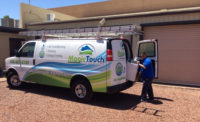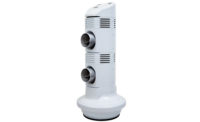Portable heating and cooling units, like most HVACR products, continue to evolve as advances in technology allow manufacturers to meet consumer demand in previously improbable applications and markets.
In fact, portable units are increasingly being used as more permanent solutions, according to Brittany Calderon, product manager – consumer products, Friedrich Air Conditioning.
“There is definite growth in this [portable] category,” Calderon said. “Traditionally, portable units have largely been consumer-oriented products used primarily for supplemental and temporary cooling in hot-spot locations, where more permanent solutions could not be provided.
“Today, we are seeing increasing use of portables as a primary means of cooling for areas, such as home offices, server rooms, and in homes that don’t have central air and only need cooling a few months out of the year,” Calderon continued. “Friedrich also is seeing more demand from HVAC contractors when it comes to offering their customers portable units as an option for supplemental cooling while work is being done to their primary systems.”
Calderon also noted she is seeing a rise in convenience features as well as smart technology being implemented in portable heating and cooling units.
“Friedrich’s dual-hose ZoneAire portable with heat pump features both cooling and heating capabilities, and it delivers cooling power at a high efficiency. This product is a perfect solution for those looking for a bit more capacity from their portables versus just a temporary solution. For simple and fast spot cooling, Friedrich also offers the ZoneAire compact single hose portable unit, which was designed with convenience in mind. From the easy-roll casters to the hose storage under the unit to the ability to quickly cool or simply spin the unit around for heat operation, this unit is all about ease of use and portability.
“Friedrich believes there will be a continued uptick in growth over the next few years, with a focus on more appealing visual designs and technical features, such as Wi-Fi connectivity and smart capabilities,” Calderon continued. “There are several factors contributing to the growth in this category. The number of companies allowing employees to work from home is growing, and the need for spot cooling during business hours in a person’s home is directly affected. Installation will continue to be simplified, allowing users to move a unit to areas in the home or office where they may need it most, conveniently and with ease.”
EXPANDING INTO NEW MARKETS
Portable cooling units are ideal solutions for today’s dynamic and challenging environments, said Mike Renier, vice president of sales, KwiKool Portable Cooling Systems.
“Customers with budget or flexibility issues are attracted to portable air conditioners, since they are generally cheaper than permanent systems and can be easily moved,” Renier said. “In addition to these criteria, portables must also offer additional features. One such recent customer need has come from the marijuana industry, where advanced features are required for control of both quality and cost.
“Marijuana growing operations require specific environmental control in the growing space for optimum production,” he continued. “These spaces are often changed due to the addition of plants and equipment. Controlling air quality, which includes both the temperature and CO2 levels, is critical. The grow lights used to stimulate plant growth also produce heat that can harm the plants. Improper CO2 levels also reduce plant growth and quality. In order to address both of these factors, it is necessary to more precisely match heat load to air conditioning capacity. When using a portable air conditioner for this application, a balanced condenser air pressure is essential. Single-duct systems create a negative pressure in the space by pushing out internal air with the hot air exhaust. The negative pressure pulls in contaminants and unconditioned air. The result for grow rooms is a loss of 25 percent of cooling efficiency and a destabilized environment. Portable air conditioners designed with this balanced air pressure as a standard feature offer the most affordable, efficient solution. KwiKool Iceberg Series portables meet these efficiency and technical criteria, since they include a standard dual-duct design.”
Data centers and server rooms are another application where portable cooling units are ideal, Renier noted.
“Information technology managers need the same affordable air conditioning solution to cool high-heat-load server rooms for primary, off-hours, or emergency backup air conditioning capabilities,” he said. “KwiKool’s sophisticated dual-duct portable units are specifically designed for the ‘new workplace.’ The Iceberg air-cooled models are the most commonly used units for these applications because they move heat load from the space being cooled to the area above the ceiling. All KwiKool models come with a temperature-activated sensor, which will automatically turn on the unit when the temperature rises above its set point. KwiKool models will also return to a previous setting after a power failure. These features combined with the dual duct condenser airflow offer the optimum solution for these dynamic applications.”
Portable manufacturers are also finding new growth opportunities in the rental industry, according to Ted Altmire, national sales manager, Sterling HVAC Engineered Products, Mestek Inc.
“In the past, our Koldwave brand of products has been sold through wholesale distribution, and they, in turn, have been selling these products to contractors for their personal use for building or construction applications or whatever their needs may be,” Altmire said. “What we’re seeing now is these products are being marketed and sold through the rental industry. As a result, we’ve adjusted our focus a little bit. We’ve made some changes in the way we go to market to try to capture some of that business. We’re still selling the products through the wholesale distribution, just like any other HVAC product, but at the same time, we’ve set up a whole new group of rental reps focused on the rental industry to make headway into those areas that are completely different from the HVAC side.”
Koldwave reps are selling products to rental houses and local rental companies that rent equipment for the construction industry as well as the party or special event industry, Altmire noted. “It’s a whole different market from the HVAC side. Additionally, we’ve also been adding products to focus on the needs of the rental industry. For example, we’ve added products, like tent rental units, designed to fit in a tent rather than inside of a building. We’ve added larger capacity equipment to our line. We used to stop at 7.5-ton capacity, but now we go up to 30 ton. We’ve also added heating and dehumidification products as a result of this, as well. That market has been overlooked, but once we got into it, we’ve seen a dramatic increase in business opportunities.”
The company has also implemented an equipment leasing program for some of its more expensive products, which has helped move the larger capacity units out the door, Altmire said. “I don’t see the market slowing down; I see it continuing to grow. In our case, we’re looking at a good 20-30 percent increase annually for the next several years, which is a very good thing.
“HVAC wholesalers should be looking at the rental side of this business for several reasons,” Altmire added. “No. 1, it’s very profitable. Return on investment for rental equipment is tenfold what it is on sales products. No. 2, their customers come into their stores every day for other HVAC equipment, but for rental products, they go elsewhere. It’s something HVAC wholesalers are missing out on.”
FOCUSING ON WORKPLACE SAFETY
According to Misty Wilburn, marketing manager for Portacool LLC, the biggest trends in the portable market are an increased focus on safety and productivity in the workplace.
“OSHA [Occupational Safety and Health Administration] is continuing to take a much stronger view of safety and how heat stress impacts workers and workplaces,” she said. “And we’re seeing more and more contractors and facility managers who are looking for portable energy-efficient solutions to keep workers cool and comfortable where traditional HVAC solutions are not practical for various reasons, whether the building is open all the time or is much too hard to air condition. Our products are offered in such a wide range of sizes that finding one that fits your needs perfectly is really not difficult anymore. There used to be only a couple of sizes of evaporative coolers, and often, they were too large or too small. Now that you’re able to find a product that fits your needs so perfectly, it’s a lot easier for managers to ward off heat stress; keep productivity up; and prevent injuries, absentees, turnovers, and things like that.”
Wilburn noted that Portacool has expanded its current product line to fit consumer demand for large or small cooling needs. “We have everything from smaller residential lines all the way up to our larger industrial products for automotive and industrial facilities or large construction sites, as well. They allow managers to cool workers in industries that have traditionally been very hot. We often forget there are people who work outside every single day and are not able to get air conditioning. Our products are designed to make those areas cooler.
“This is not going to go away,” she continued. “Heat stress prevention is going to continue to be a focus of businesses in the U.S. going forward. Along with that, businesses are geared to be as productive as possible. They’re working smarter and more efficiently.
“To reach productivity goals, they have to ensure their workers are comfortable and their morale is as high as possible,” continued Wilburn. “Working in hot, miserable environments is just not fun. Studies from NASA and the U.S. military have shown that hot workers are just not as productive and are actually more accident prone. We think keeping workers cool, comfortable, productive, and safe is going to become more important as we go forward in the future.”
ENVIRONMENTALLY FRIENDLY
In addition to advanced features, another trend the portable market is currently experiencing, and has been for some time, is improving energy efficiency, water efficiency, and overall carbon footprint, according to Stephani Bisignano, national sales manager, Cool-Space.
“Unlike many commercial cooling systems, Cool-Space evaporative cooling doesn’t use harmful CFCs [chlorofluorocarbons] or HFCs [hydrofluorocarbons],” Bisignano said. “Our units simply use air, water, and single-phase electricity to operate. We’re a natural cooling choice for environmentally friendly companies.
“There is significant customer interest in purchasing products made in the USA by dependable companies,” she added. “Cool-Space, proudly made in the USA, is a second-generation, family-owned and operated company based in Fortville, Indiana. The Hale Family pledge is to simply build the best evaporative cooling units utilizing top components, like whisper quiet motors, Greenguard cooling media, and GFCI [ground fault circuit interrupter]-protected cords for safety. It’s all backed with a five-year warranty and 30-plus years of experience in the HVAC market. Buyers want to know they’re working with a reliable company offering customer service that’s accessible. Cool-Space has a dedicated focus on customer service with guaranteed customer response time and ultimate satisfaction. Our commitment continues beyond the equipment — it extends to the consumers.”
Publication date: 7/3/2017
Want more HVAC industry news and information? Join The NEWS on Facebook, Twitter, and LinkedIn today!












